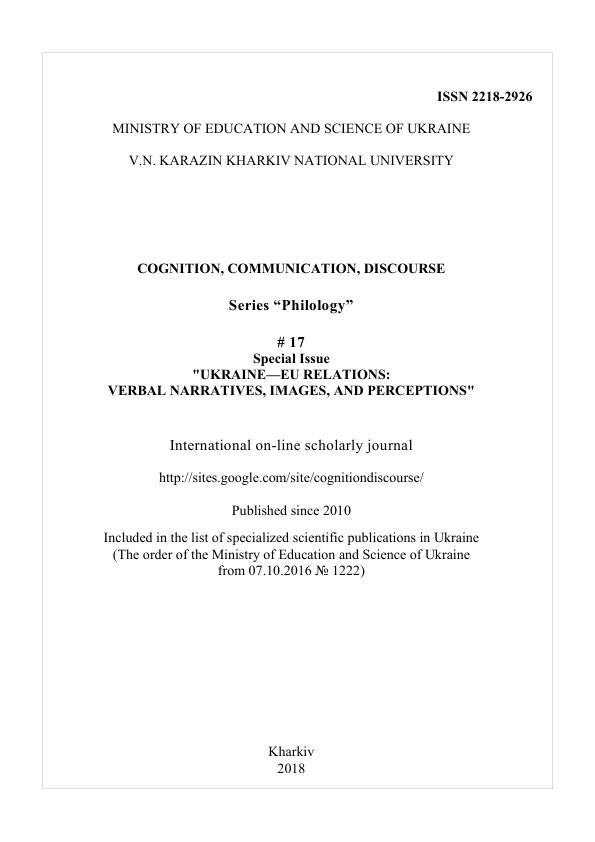Політичні образи та сприйняття на міждисциплінарному перехресті. Вступ до тематичного випуску "Відносини між Україною та ЄС: вербальні наративи, образи та сприйняття"
Анотація
Цей тематичний випуск журналу містить доробок міжнародного дослідницького проекту "Криза, конфлікт та критична дипломатія: сприйняття Євросоюзу Україною та Ізраїлем / Палестиною" (C3EU) (2015-2018) у частині, пов'язаною з Україною [C3EU, online]. Проект C3EU, підтриманий програмою Єврокомісії "Еразмус+", поєднав 36 досвідчених та молодих фахівців, які у своєму дослідженні послуговувалися сучасними досягненнями студій, присвячених сприйняттю ЄС. Результати проекту стали внеском у дебати стосовно участі ЄС у регуляції глобальних і локальних процесів та стимулювали науково обґрунтований діалог між політичними колами України та ЄС. Орієнтований на отримання конкретних практичних результатів, дослідницький колектив C3EU намагався досягти академічної якості шляхом опрацювання мовних та позамовних даних за допомогою ретельно розробленого методологічного апарату, який дозволяє виявити особливості сприйняття ЄС в Україні та Ізраїлі / Палестині з урахуванням основних суспільних викликів сучасності. Статті, опубліковані в цьому тематичному номері, присвяченому сприйняттю та образам ЄС, України та відносинам між ними, є міждисциплінарними. Воно поєднують методологічні положення когнітивної та комунікативної лінгвістики із положеннями комунікативних і медійних студій, культурології, політології, а також студій у галузях міжнародних відносин та європейської інтеграції.
Завантаження
Посилання
C3EU (Crisis, Conflict and Critical Diplomacy: EU Perceptions in Ukraine, Israel and Palestine), Available from: https://jeanmonnet.nz/c3eu/.
Chaban, N., Magdalena, A.-M. (2014). External perceptions of the EU during the Eurozone Sovereign Debt Crisis. European Foreign Affairs Review, 19 (2), 195–220.
Chaban, N., & Holland, M. (eds.) (2014). Communicating Europe in Times of Crisis: External Perceptions of the European Union. Houndmills: Palgrave Macmillan.
Chaban, N., & Holland, M. (eds.) (2018). Shaping the EU’s global strategy: partners and perceptions. Houndsmill: Palgrave McMillan.
Chaban, N., Elgström, O., Kelly S., & Lai S.-Y. (2013). Images of the EU beyond its borders: Issue-specific and regional perceptions of EU power and leadership. Journal of Common Market Studies, 51 (3): 433-451.
Entman, R.M. (2003). Cascading activation: Contesting the White House’s frame after 9/11. Political Communication, 20 (4), 415–432.
Entman, R.M. (2004). Projections of power: framing news, public opinion, and U.S. foreign policy. Chicago: University of Chicago Press.
EU Global Strategy (EUGS) (2016). Available from http://europa.eu/globalstrategy/en/global-strategy-foreign-and-security-policy-european-union
Hall, S. (1997). Representation: cultural representations and signifying practices. London: Thousand Oaks, Calif: Sage, in association with the Open University.
Georgakopoulou, A. (2007). Small stories, interaction and identities. Amstrdam / Philadelphia: John Benjamins.
Hall, S. (1980/2001). Encoding/Decoding. In M.G. Durham and D. Kellner (eds.) Media and Cultural Studies: Keyworks. Oxford: Blackwell, 166-176.
Harnisch, S., Frank, C., & Maull, H.W. (eds.) (2011). Role Theory in International Relations. London and New York: Routledge.
Holsti, K. (1970). National role conceptions in the study of foreign policy’. International Studies Quarterly, 14 (3), 233-309.
Horbyk, R. (2017) Mediated Europes: discourse and power in Ukraine, Russia and Poland during Euromaidan. Published PhD dissertation, Södertön University Doctoral Dissertations.
Lakoff, G., & Johnson, M. (1980). Metaphors we live by. Chicago: University of Chicago Press.
Nadelmann, E. (1990). Global prohibition regimes: The evolution of norms in international society. International Organization, 44 (4): 479–526.
Peeren, E., Horskotte, S. (2007). Introduction: The shock of the other. In S. Horskotte and E. Peeren (eds.). The shock of the other: situations alterities. Amsterdam, New York: Rodopi.
Pickering, M. (2001). Stereotyping: The Politics of Representation. Houndmills: Palgrave Macmillan.
Said, E. W. (1978). Orientalism. London: Penguin.
Zhabotynskaya, S. (2016). Kontseptualnyie metaforyi v rechah Baraka Obamyi i Vladimira Putina (2014–2015) [Conceptual metaphors in the public speeches of Barack Obama and Vladimir Putin (2014–2015)]. Cognition, communication, discourse, 13. (In Russian). Available from: https://sites.google.com/site/cognitiondiscourse/vypusk-no13-2016/zabotinskaa-s-a
Автори, які публікуються у цьому журналі, погоджуються з наступними умовами:
Автори залишають за собою право на авторство своєї роботи та передають журналу право першої публікації цієї роботи на умовах ліцензії Creative Commons Attribution License (CC BY), яка дозволяє іншим особам вільно розповсюджувати опубліковану роботу з обов'язковим посиланням на авторів оригінальної роботи та першу публікацію роботи у цьому журналі.
Автори мають право укладати самостійні додаткові угоди щодо неексклюзивного розповсюдження роботи у тому вигляді, в якому вона була опублікована цим журналом (наприклад, розміщувати роботу в електронному сховищі установи або публікувати у складі монографії), за умови збереження посилання на першу публікацію роботи у цьому журналі.
Політика журналу дозволяє і заохочує розміщення авторами в мережі Інтернет (наприклад, у сховищах установ або на особистих веб-сайтах) рукопису роботи, як до подання цього рукопису до редакції, так і під час його редакційного опрацювання, оскільки це сприяє виникненню продуктивної наукової дискусії та позитивно позначається на оперативності та динаміці цитування опублікованої роботи (див. The Effect of Open Access).




